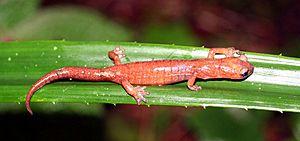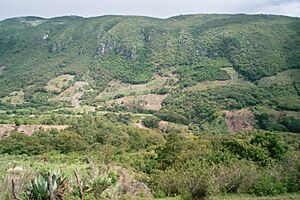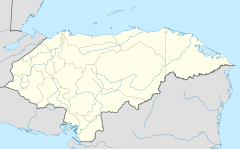Celaque National Park facts for kids
Quick facts for kids Celaque National Park |
|
|---|---|
|
IUCN Category II (National Park)
|
|

San Isidro, a small town located in Celaque's mounts.
|
|
| Location | Lempira Department, Honduras Ocotepeque. |
| Area | 266.4 km2 (102.9 sq mi) |
| Established | 5 August 1987 |
Celaque National Park (also known as Parque Nacional Montaña de Celaque in Spanish) is a special natural area in western Honduras. It is found in the Lempira, Ocotepeque, and Copán regions. This park was created on August 5, 1987. It covers a large area of about 266 square kilometers (103 square miles).
Celaque National Park is home to Honduras' tallest mountain. This peak is called Cerro Las Minas or Pico Celaque. It reaches about 2,870 meters (9,416 feet) above sea level. The park's land is very rugged, with many steep slopes.
Celaque is known as a cloud forest. This means it often has clouds and mist, which helps many plants grow. It gets a lot of rain, especially at higher altitudes. The word celaque is thought to mean "box of water" in the old Lenca language. This makes sense because Celaque's nine rivers provide water to 120 villages nearby. This includes the main town of Gracias.
The park is full of different kinds of plants and animals, which is called biodiversity. You can find amazing creatures here like pumas and ocelots. It is also the only place in the world where you can find the Bolitoglossa celaque, an endangered type of salamander.

Contents
Why Celaque Became a Park
In the 1970s and 1980s, a lot of trees were cut down in Celaque's mountains. This was done by the Honduran Forestry Development Corporation. Cutting down so many trees harmed the park's amazing plants and animals. It also took away important resources from the local communities.
Besides large-scale logging, people living near the park also cleared small areas of forest for farming. This created open patches in the forest. The people of La Campa, a nearby town, were worried about this. They formed a group to try and stop the logging. Their hard work paid off in 1987. The National Congress of Honduras officially made Celaque a national park.
By creating the park, about 266 square kilometers (103 square miles) of land became protected. This meant it was safe from large-scale logging, farming, and other activities that could harm the forest.
Early Efforts to Protect the Park

After Celaque became a national park, people wondered if it was truly helping the environment. Studies done between 1987 and 1998 showed some good news. The amount of open forest land actually decreased. Also, mature forests (older, well-grown forests) became the largest type of forest in the park.
This meant that the forest was starting to recover in some areas. However, this improvement was mostly seen in parts of the park that were remote and had no villages. It was also in areas that already had mature trees. This showed that while the park's protection was helping, it wasn't enough to save all of Celaque's unique plants and animals.
Ongoing Challenges for Conservation
More recent studies have shown that the park still faces big challenges. The positive changes in the park's environment slowed down after 1995. Even though the park stops outside logging and large-scale farming, it does not limit the communities living inside its borders.
The areas where people farm around the park's edges have grown a lot. This is because more communities are farming there. Deeper inside the park, more land is being used for farming. Some of this farming uses fertilizers that are not good for the environment in the long run. The number of people living in the park has also grown. There are eight communities in the upper part of Celaque.
While only a small part of the land is used for small farms, much of the damage still comes from logging that is not allowed. Also, large-scale farming for businesses is a problem. Because there is a high demand for coffee beans, the slopes of Celaque now have more coffee farms than ever before.
Working Towards a Better Future
Even though making Celaque a national park was a good step, it wasn't enough to stop all harmful activities. Many groups in Honduras are working hard to protect Celaque's beautiful mountains.
One of these groups is The Federacion de Desarrollo Comunitario de Honduras (FEDECOH). This group teaches communities how to farm in ways that do not harm the environment. They have a 60-acre (24-hectare) farm called El Molino at the base of Celaque. Here, they teach about keeping soil healthy, rotating crops, and protecting biodiversity. Over ten years, they have taught thousands of farmers in 120 rural communities. Their newest project is to encourage ecotourism in Celaque National Park. This means people can visit the park in a way that helps protect it and supports local communities.
Another group is Friends of Celaque. This organization was started by people who cared deeply about the park. Their goals include telling more people about the park's importance. They also want to work with other environmental groups. They hope to attract ecologists, biologists, and other scientists who are interested in helping the park. They also want to show that protecting the park's resources will benefit the people living nearby.
These organizations and many others are doing a lot to protect Celaque National Park. But more people need to know about this special place to help keep it safe for the future.
See also
 In Spanish: Parque nacional Celaque para niños
In Spanish: Parque nacional Celaque para niños



